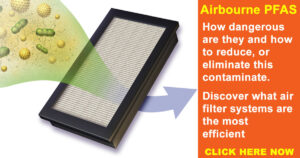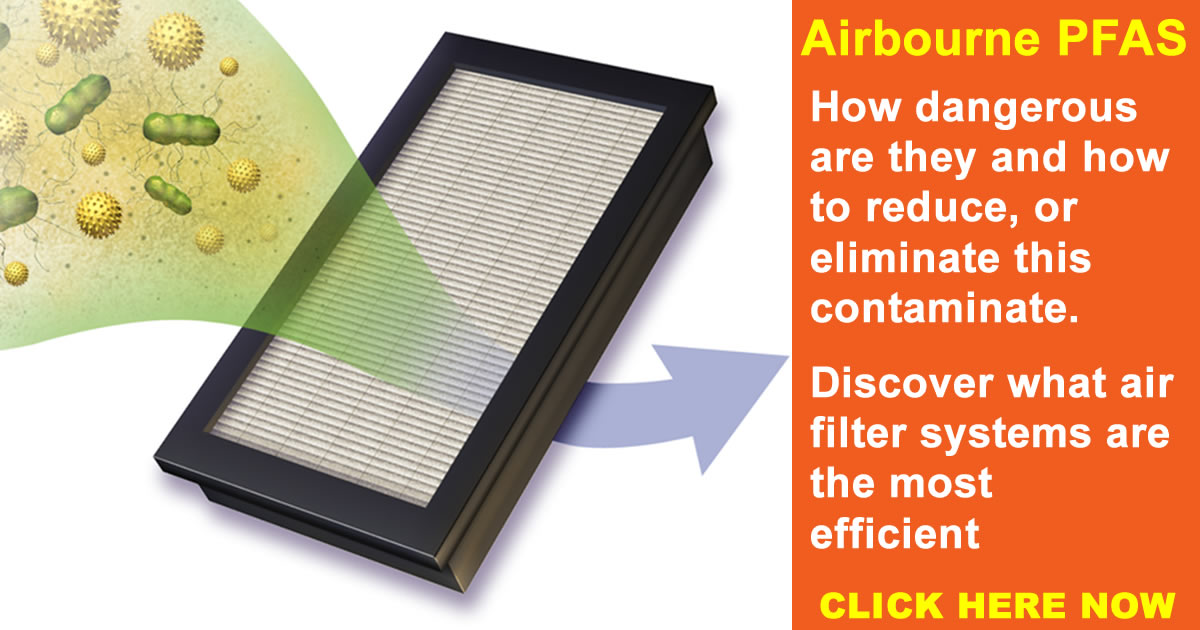How to Reduce Air Exposure to PFAS
 The “some consumer products” the state of Maine outlawed were rugs and large area products that could easily produce “off-gassing”. New carpets go through a period of ‘off-gassing’, just as other un-natural products. Off-gassing is the process of which the chemicals that were used to create the products release themselves into the air, i.e. they become aerosolized. Both California[3] and New York[4] have outlawed food packaging containing PFASs.
The “some consumer products” the state of Maine outlawed were rugs and large area products that could easily produce “off-gassing”. New carpets go through a period of ‘off-gassing’, just as other un-natural products. Off-gassing is the process of which the chemicals that were used to create the products release themselves into the air, i.e. they become aerosolized. Both California[3] and New York[4] have outlawed food packaging containing PFASs.
- Off-Gassing from Carpets; Typical “off-gassing” reactions to new carpet[5] VOCs and PFCAs include headaches, nausea, dizziness, shortness of breath, and asthmatic reactions[6]. Off-gassing decreases significantly after a few months from installation, however, carpets can emit VOCs for five years (or possibly more)[7].
- Off-Gassing by Non-Stick Cookware; Never cook on high heat. It can release PFAS into food or the air. Scratches can also cause the release of PFAS, so always use wooden cooking utensils. At temperatures above 500°F (260°C), the non-stick PFAS start to break down, releasing the toxic chemicals fumes into the air[8]. A person can develop symptoms known as the “Teflon flu”. These are flu-like symptoms such as chills, fever, headache. The symptoms usually appear within 4–10 hours of exposure, resolve within 12–48 hours[9]. Serious side effects can include lung damage.
- Leaching; Studies show that PFAS can leach into food from plastic containers containing PFASs in as little as one week. High temperature also accelerated leaching[10].
A UV/Ozone Combination System; appears to provide the ability to remove PFAS from the air, coming in at a 75% removal rate, versus UV alone at 16.8%[11]. Stand alone filter systems are available. Here is one example. Here is another example if you have central heating for the whole house.
HEPA and Activated Carbon Filters; HEPA filters remove radiation[12], and you can purchase activated carbon filters that remove both radiation and airborne PFASs. Ideally, if you have a central air heating and/or colling system, and using both would provide the optimal benefits, however their life expectancy is short lived, needing replaced every three to six months.
NEXT: How to Reduce Food Exposure to PFAS
<<<<BACK NEXT>>>
Citations
[1] https://legislature.maine.gov/statutes/38/title38sec1614.html
[2] https://www.maine.gov/dep/spills/topics/pfas/PFAS-products/
[3] https://dtsc.ca.gov/scp/food-packaging-containing-pfass/
[4] https://dec.ny.gov/environmental-protection/recycling-composting/businesses/pfas-in-food-packaging
[5] https://apps.ecology.wa.gov/publications/documents/2104048.pdf
[6] Becher R, Øvrevik J, Schwarze PE, Nilsen S, Hongslo JK, Bakke JV. Do Carpets Impair Indoor Air Quality and Cause Adverse Health Outcomes: A Review. Int J Environ Res Public Health. 2018 Jan 23;15(2):184. doi: 10.3390/ijerph15020184. PMID: 29360764; PMCID: PMC5858259.
[7] https://www.mothernaturescleaning.com/battling-vocs-off-gassing/
[8] Sajid M, Ilyas M. PTFE-coated non-stick cookware and toxicity concerns: a perspective. Environ Sci Pollut Res Int. 2017 Oct;24(30):23436-23440. doi: 10.1007/s11356-017-0095-y. Epub 2017 Sep 14. PMID: 28913736.
[9] Shimizu T, Hamada O, Sasaki A, Ikeda M. Polymer fume fever. BMJ Case Rep. 2012 Dec 10;2012:bcr2012007790. doi: 10.1136/bcr-2012-007790. PMID: 23230259; PMCID: PMC4544973.
[10] Environ. Sci. Technol. Lett. 2023, 10, 4, 350–355, Publication Date:March 6, 2023, https://doi.org/10.1021/acs.estlett.3c00083 American Chemical Society
[11] Comparative study of PFAS treatment by UV, UV/ozone, and fractionations with air and ozonated air, X. Dai, Z. Xie, B. Dorian, S. Gray and J. Zhang, Environ. Sci.: Water Res. Technol., 2019, 5, 1897 DOI: 10.1039/C9EW00701F
[12] Min-Ho Lee, Wonseok Yang, Nakkyu Chae, Sungyeol Choi, Performance assessment of HEPA filter against radioactive aerosols from metal cutting during nuclear decommissioning,Nuclear Engineering and Technology, Volume 52, Issue 5, 2020, Pages 1043-1050,ISSN 1738-5733, https://doi.org/10.1016/j.net.2019.10.017.https://www.sciencedirect.com/science/article/pii/S173857331930628X

